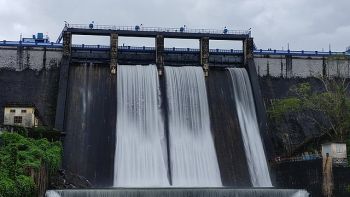Swift Currents over Spillways: Difference between revisions
No edit summary |
No edit summary |
||
| (2 intermediate revisions by 2 users not shown) | |||
| Line 2: | Line 2: | ||
[[Category:Risk Assessment Public Safety]] | [[Category:Risk Assessment Public Safety]] | ||
---- | ---- | ||
{{Picture | |||
<!-- Add image file name (ex.image.jpg) --> | |||
|image= Peechi_Dam.jpg | |||
<!--Add link if applicable --> | |||
|link= | |||
<!-- Add picture caption --> | |||
|caption= Peechi Dam, India. | |||
(Image Source: [https://commons.wikimedia.org/wiki/File:Peechi_Dam_3.jpg Wikimedia]) | |||
}} | |||
<!-- Delete any sections that are not necessary to your topic. Add pictures/sections as needed --> | <!-- Delete any sections that are not necessary to your topic. Add pictures/sections as needed --> | ||
Water flows over low-head dams and over dam [[spillways]] are particularly dangerous as they may be difficult to recognize and may not be visible from upstream, due to their low profile and false-horizon appearance. If the crest of the dam is left unmarked and unprotected, boaters in the reservoir can be drawn over the dam or spillway. Jet skiers, canoes, kayaks, and power boats have driven off the crest of low-head dams, unaware of the sudden drop, with tragic consequences. More often, motor boaters experience engine problems and lose control of their boats and are carried by the current over the edge. | Water flows over low-head dams and over dam [[spillways]] are particularly dangerous as they may be difficult to recognize and may not be visible from upstream, due to their low profile and false-horizon appearance. If the crest of the dam is left unmarked and unprotected, boaters in the reservoir can be drawn over the dam or spillway. Jet skiers, canoes, kayaks, and power boats have driven off the crest of low-head dams, unaware of the sudden drop, with tragic consequences. More often, motor boaters experience engine problems and lose control of their boats and are carried by the current over the edge. | ||
| Line 11: | Line 21: | ||
Dam owners and operators should also be cognizant of these dangerous hydraulic hazards and mark the approaches to the dam and spillway entrances with signs, buoys or log booms. | Dam owners and operators should also be cognizant of these dangerous hydraulic hazards and mark the approaches to the dam and spillway entrances with signs, buoys or log booms. | ||
==Best Practices Resources== | <noautolinks>==Best Practices Resources==</noautolinks> | ||
{{Document Icon}} [[Dam Safety Warning Signs Best Practices (FEMA P-2188)|Dam Safety Warning Signs Best Practices ( | {{Document Icon}} [[Dam Safety Warning Signs Best Practices (FEMA P-2188) | Dam Safety Warning Signs Best Practices (FEMA P-2188), FEMA]] | ||
<!-- For information on notation for in text citations visit https://www.mediawiki.org/wiki/Help:Cite Or simply enclose the citation as shown <ref> citation </ref> in the location of the in text mention. Citations will automatically populate below--> | <!-- For information on notation for in text citations visit https://www.mediawiki.org/wiki/Help:Cite Or simply enclose the citation as shown <ref> citation </ref> in the location of the in text mention. Citations will automatically populate below--> | ||
Latest revision as of 18:23, 19 July 2023

|
| Peechi Dam, India.
(Image Source: Wikimedia) |
Water flows over low-head dams and over dam spillways are particularly dangerous as they may be difficult to recognize and may not be visible from upstream, due to their low profile and false-horizon appearance. If the crest of the dam is left unmarked and unprotected, boaters in the reservoir can be drawn over the dam or spillway. Jet skiers, canoes, kayaks, and power boats have driven off the crest of low-head dams, unaware of the sudden drop, with tragic consequences. More often, motor boaters experience engine problems and lose control of their boats and are carried by the current over the edge.
If the width of the stream or reservoir narrows on the approach to a dam or spillway structure, the currents over the dam head will increase in velocity. This change in speed can catch people by surprise, drawing in swimmers, kayakers, canoers, and motor boaters towards the dam and over it before they have a chance to respond.
Before heading out on any waterway or body of water, it is critical to view a map (not all dams are indicated on maps, however), ask a local to point out hazards, look out for signage indicating hazards and dams (these are not always present), and always remain alert to the possibility of changes in currents near dam structures. It may be necessary to pull out a safe distance upstream and portage the hazard before re-entering the water a safe distance downstream away from the drop or hazardous hydraulic. Oftentimes people do not have time to get out of the water above the hydraulic or put back in the water too close to the hydraulic downstream and face catastrophic consequences.
Dam owners and operators should also be cognizant of these dangerous hydraulic hazards and mark the approaches to the dam and spillway entrances with signs, buoys or log booms.
Best Practices Resources
![]() Dam Safety Warning Signs Best Practices (FEMA P-2188), FEMA
Dam Safety Warning Signs Best Practices (FEMA P-2188), FEMA
Citations:
Revision ID: 7330
Revision Date: 07/19/2023
